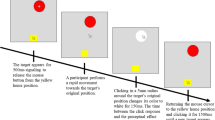Summary
Transformations of the underlying movement control of rapid sequential (reversal) responses were examined as the movement amplitude (Experiment 1) and moment of inertia (Experiment 2) were altered, with constant movement time. Increases in amplitude and inertia were both met by sharply increased joint torques with a constant temporal structure, suggesting that the alterations may have been governed by a single gain parameter. The durations of various EMG bursts were essentially constant across changes in inertia, supporting a model in which the output of a fixed temporal representation is amplified to alter joint torques. The EMG amplitudes increased greatly with both amplitude and load. However, the fact that the EMG durations increased systematically with increases in distance provided difficulties for this model of amplitude control. The data suggest an economy in motor control in simple agravitational movements, whereby relatively simple transformations of an underlying representation can accomodate large changes in movement amplitude and moment of inertia.
Similar content being viewed by others
References
Benecke R, Meinck H-M, Conrad B (1985) Rapid goal-directed elbow flexion movements: limitations of the speed control system due to neural constraints. Exp Brain Res 59: 470–477
Berardelli A, Rothwell JC, Day BL, Kachi T, Marsden CD (1984) Duration of the first agonist EMG burst in ballistic arm movements. Brain Res 304: 183–187
Brown SHC, Cooke JD (1981) Amplitude- and instruction-dependent modulation of movement-related electromyogram activity in humans. J Physiol 316: 97–107
Brown SH, Cooke JD (1984) Initial agonist burst duration depends upon movement duration. Exp Brain Res 55: 523–527
Carter MC, Shapiro DC (1984) Control of sequential movements: evidence for generalized motor programs. J Neurophysiol 52: 787–796
Cooke JD, Brown S, Forget R, Lamarre Y (1985) Initial agonist burst durations changes with movement amplitude in a deafferented patient. Exp Brain Res 60: 184–187
Enoka RM (1983) Muscular control of a learned movement: the speed control system hypothesis. Exp Brain Res 51: 135–145
Flowers KA (1976) Visual ‘closed-loop’ and ‘open-loop’ characteristics of voluntary movement in patients with parkinsonism and intention tremor. Brain 99: 269–310
Freund HJ, Büdingen HJ (1978) The relationship between speed and amplitude of the fastest voluntary contractions of human arm muscles. Exp Brain Res 31: 1–12
Gentner DR (1987) Timing of skilled motor performance: tests of the proportional duration model. Psych Rev 94: 255–276
Ghez C (1979) Contributions of central programs to rapid limb movement in the cat. In: Asanuma H, Wilson VJ (eds) Integration in the nervous system. Isaku-Shoin, Tokyo, pp 305–319
Ghez C, Vicario D (1978) The control of rapid limb movement in the cat. Scaling of isometric force adjustments. Exp Brain Res 33: 199–202
Gielen CCAM, van den Oosten K, ter Gunne FP (1985) Relation between EMG activation and kinematic properties of aimed arm movements. J Mot Behav 17: 421–442
Hallett M, Marsden CD (1979) Ballistic flexion movements of the human thumb. J Physiol 294: 33–50
Hay JC (1973) The biomechanics of sports techniques. Prentice Hall, Englewood Cliffs, NJ
Hollerbach JM (1981) An oscillation theory of handwriting. Biol Cybern 39: 139–156
Hollerbach JM (1984) Personal communication
Lestienne F (1979) Effects of inertial load and velocity on the braking process of voluntary limb movements. Exp Brain Res 35: 407–418
Merton PA (1972) How we control the contraction of our muscles. Sci Am 226: 30–37
Meyer DE, Smith JEK, Wright CE (1982) Models for the speed and accuracy of aimed limb movements. Psychol Rev 89: 449–482
Newell KM, Carlton LG, Carlton MJ, Halbert JA (1980) Velocity as a factor in movement timing accuracy. J Mot Behav 12: 47–56
Raibert MH (1977) Motor control and learning by the state space model. Technical Report No. AI-TR-439, Artificial Intelligence Laboratory, MIT
Schmidt RA (1987) Motor control and learning: a behavioral emphasis (rev edn). Human Kinetics, Champaign, IL
Schmidt RA, Sherwood DE, Walter CB (1987) Rapid movements with reversals in direction. I. The control of movement time. Exp Brain Res 69: 344–354
Schmidt RA, Sherwood DE, Zelaznik HN, Leikind BJ (1985) Speed-accuracy trade-offs in motor behavior: theories of impulse variability. In: Heuer H, Kleinbeck U, Schmidt K-H (eds) Motor behavior: programming, control, and acquisition. Springer, Berlin Heidelberg New York Tokyo
Schmidt RA, Zelaznik HN, Hawkins B, Frank JS, Quinn JT (1979) Motor-output variability: a theory for the accuracy of rapid motor acts. Psychol Rev 86: 415–451
Schneider K, Zernicke RF, Schmidt RA, Hart TJ (1987) Learning of unrestrained rapid arm movements. II. Coordination of intersegmental dynamics. (submitted) UCLA
Shapiro DC, Walter CB (1986) The control of rapid positioning movements with spatiotemporal constraints. J Mot Behav 18: 373–395
Sherwood DE (1983) The impulse-variability model: tests of the major assumptions and predictions. Ph.D. dissertation, University of Southern California
Wadman WJ, Denier van der Gon JJ, Geuze RH, Mol CR (1979) Control of fast goal directed arm movements. J Hum Mov Stud 5: 3–17
Wallace SA (1981) An impulse-timing theory for reciprocal control of muscular activity in rapid, discrete movements. J Mot Behav 13: 144–160
Wallace SA, Wright L (1982) Distance and movement time effects on the timing of agonist and antagonist muscles: a test of the impulse-timing theory. J Mot Behav 14: 341–352
Walter CB (1984) Temporal quantification of electromyography with reference to motor control research. Hum Mov Sci 3: 155–162
Zelaznik HN, Schmidt RA, Gielen CCAM (1986) Kinematic properties of rapid aimed hand movements. J Mot Behav 18: 353–372
Author information
Authors and Affiliations
Rights and permissions
About this article
Cite this article
Sherwood, D.E., Schmidt, R.A. & Walter, C.B. Rapid movements with reversals in direction. Exp Brain Res 69, 355–367 (1988). https://doi.org/10.1007/BF00247580
Received:
Accepted:
Issue Date:
DOI: https://doi.org/10.1007/BF00247580




